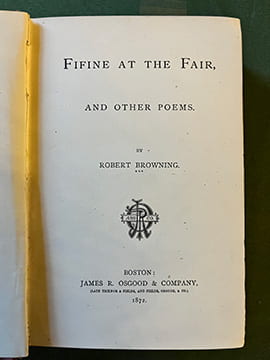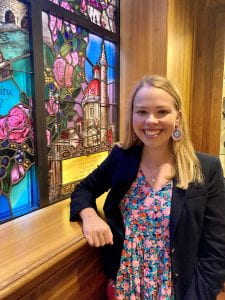by Anna Clark, Master’s Student in History and Armstrong Browning Library Graduate Research Assistant
Every fall semester, the Armstrong Browning Library hosts a guest lecturer to celebrate Benefactors Day. The annual event, held this year on October 20th in the Hankamer Treasure Room, recognizes our benefactors who support the Armstrong Browning Library in its mission to educate and share with visitors the lives and works of the Brownings and their Victorian contemporaries. We would like to extend our gratitude to the Guardian Angel Fund who made this year’s celebration possible.
On this Benefactors Day, Library Director Jennifer Borderud highlighted the generosity of the Brown Foundation, which sponsors the Armstrong Browning Library’s Margarett Root Brown Chair in Robert Browning and Victorian Studies at Baylor University. Established in 1970, the Brown Foundation funds the current scholar-in-residence’s research and public scholarship.
This year’s lecturer was Dr. Kristen Pond, our newly selected Margarett Root Brown Chair, who gave a presentation titled “It’s Okay to Talk to Strangers: Charles Dickens and Charlotte Brontë on Enchanting Encounters.” Her lecture was her inaugural address after being named the seventh Browning Chair this fall, and Dr. Pond will continue to collaborate with the ABL in the years to come as our in-house scholar on all things Browning and Victorian.
In her talk, Dr. Pond explored the ways we experience both wonder and enchantment in our lives and how encounters with strangers are often linked to these feelings of wonder and enchantment. Her address draws from her research on the importance of space and the figure of the stranger in Victorian literature.

Dr. Kristen Pond, the new Margarett Root Brown Chair of Robert Browning and Victorian Studies at Baylor University
In addition to serving as our new Margarett Root Brown Chair, Dr. Pond is also an Associate Professor in the Baylor English Department, the Interim First-Year Writing Director, and an Affiliate Faculty Member of the Women’s and Gender Studies Department. She teaches courses on 18th and 19th century British literature, and her research largely focuses on the 19th century novel, its development, and the rhetoric and ethics of sympathy. Her new book, Strangers and the Enchantment of Space in Victorian Fiction, 1830-1865, was just released this October and delves further into the themes she discussed in her Benefactors Day lecture.
Wonder and Enchantment
Dr. Pond opened her lecture with a question to the audience, asking them to think about the last time they were filled with wonder. As attendees reflected on this question, Pond showed pictures of her hikes in the mountains of North Carolina and special moments spent with her children. The sense of wonder, Pond suggested, not only comes from a feeling of awe but also some sort of disruption, something outside the ordinary events of daily life. She posited the idea that to wonder at something is to not have an immediate answer or explanation for the thing you are wondering about and to be surprised or astonished by it.
Pond then explained that Victorian authors often thought and wrote about this feeling of wonder in their works, but they often used the word “enchantment” instead. As Pond described, to be enchanted by something is to be charmed, delighted, enraptured, or even spellbound by it. Pond suggested that we often use the word “wonder” in modern language because we all have access to wonder, whereas the word “enchantment” has a magical and mysterious connotation to it. To clarify further the differences between the two words, Pond explained that wonder is often depicted as a good emotion, but enchantment can be either good or bad. Later in her lecture, Pond explored the negative side of enchantment through the character of Jane Eyre.

Personally, I am filled with a sense of wonder whenever I look down at the Foyer of Meditation from the 3rd floor balcony.
Victorians and Strangers
Pond described how Victorians lived in an age of incredible scientific discovery and technological advancement, and new modes of transport, such as the train, offered more opportunities to explore the world beyond their familiar scenes of close friends and neighbors. Their growing mobility as a culture meant more encounters with strangers.
Strangers, in particular, evoked both fear and delight in the hearts of Victorians. This double-edged emotion of fear and delight, as Pond explicated, is part of this feeling of enchantment. For the Victorian traveler, the figure of the unknown stranger offered endless possibilities beyond their own realm of experience and knowledge. Handbooks on proper railway etiquette and how to interact with other passengers were popular among Victorians.
This Victorian fascination with strangers is also seen in their fiction, as authors often examined this tension between the ordinary and the extraordinary. Pond explained that this tension is a space for wonder and enchantment. The railway as a space appealed to the romanticized idea of the journey and encountering others on their own personal journeys. Charles Dickens, in particular, was fascinated by the possibility of an encounter with an unknown stranger and explored this enchantment in both his personal life and literature.

Image of a Victorian-era train taken from the UK National Archives
Charles Dickens and the Railway as a Space of Enchantment in Mugby Junction
In June 1865, Charles Dickens rode the South Eastern Railway Folkestone to London boat train, and the train derailed while crossing a viaduct, plunging from the bridge into the riverbed below. The crash resulted in the deaths of ten passengers and the injuries of another forty. Dickens and his companions were unharmed, but the traumatic experience had a profound effect on Dickens. Some of the passengers died while he tended to them, and he had to crawl back into the carcass of the train to retrieve his papers for the last installment of Our Mutual Friend. For the rest of his life, Dickens was extremely wary of railway travel and sought alternative means of transportation whenever feasible.

Engraving of the 1865 Staplehurst Rail Crash from the Illustrated London News
Despite his fear of trains, Dickens was fascinated by the railway and wrote Mugby Junction, a collection of short stories all centered around the railway as a space of enchanting encounters. In her lecture, Pond focused on two of these stories, “Barbox Brothers” and “Barbox Brothers & Co.” The character of Jackson in these two stories undergoes transformative experiences at the Mugby Junction station because of his encounters with strangers.
In “Barbox Brothers,” Jackson is first described as a solitary and unhappy man, but his encounter with Phoebe opens his eyes to the magic of the railway and the enchanting possibilities it offers. Phoebe is a sick and bedridden young woman, but unlike her body, her mind is active. As she listens to the constant activity at the station from her window, she envisions exciting journeys to exotic places and lands that she has only encountered in her imagination. The junction as a space connects Phoebe to things and places she will never see. Thanks to Phoebe, Jackson learns to appreciate the railway as a space of enchantment and begins to take an interest in the people around him. He starts to see the world through Phoebe’s eyes and to view the railway as an imagined community, connected through shared journeys. He promises to observe the people at the seven railway lines that intersect at the junction and to visit Phoebe again, so he can describe them to her and make her imagined stories a reality.
Dickens’ second installment in the Mugby Junction series, “Barbox Brothers & Co,” again follows Jackson as he meets another enchanting and imaginative girl. Polly, whom Jackson encounters in a town at the end of the seventh railway line, asks him to tell her a story. At first, Jackson tells her that he does not have any stories to tell her, and she admonishes him. Then Polly spins a tale about a fairy, and Jackson’s imagination is opened to other perspectives of the world. He gets over his initial awkwardness with the little girl and continues her story about the fairy. In doing so, Jackson begins to deviate from his self-centeredness and to consider other people’s happiness. Polly turns out to be the daughter of the woman he once loved, and his kindness towards Polly changes her mother’s view of him. In the end, Jackson settles down in Mugby Junction and spends the rest of his days doting both on Phoebe and Polly.
Ultimately, Dickens’ two stories, Pond argued, are about human relationships. Through the characters of Jackson, Phoebe, and Polly, Dickens portrays the railway as a space of enchantment, where encounters with strangers could expand the imagination and foster meaningful connections with others. Jackson is utterly transformed by his encounters with Phoebe and Polly into a much happier and personable man.

In her lecture, Pond recognized the ABL’s possession of the Every Saturday journal in our collections, this copy having installments of Dickens’ Mugby Junction.
Charlotte Brontë and Becoming a Stranger in Jane Eyre
Pond then shifted her attention to another famous Victorian author: Charlotte Brontë. In her novel, Jane Eyre, Brontë shows us that it’s okay to be a stranger too. In addition to the importance of talking to strangers, Pond stressed the reality that we may sometimes be the stranger ourselves. Brontë’s titular character Jane chooses to become a stranger again and again throughout the novel.
Pond asked the audience to reimagine the novel as a journey that follows Jane from Gateshead Hall, the family home of her unkind aunt and cousins, the Reeds; Lowood School, where she receives an education and loses her only friend Helen Burns; Thornfield Hall, where she becomes a governess for Adele and falls in love with Mr. Rochester; Moor House, a place of refuge after her flight from Thornfield upon learning the existence of Bertha Mason Rochester and the home of St. John Rivers and his two sisters; and finally to Ferndean Manor, the secluded house where Jane seeks out Mr. Rochester to rekindle their relationship after Bertha burns down Thornfield. Every time Jane leaves one of these places, she becomes a stranger again, but she does so to preserve something inside her that is fundamental to who she is as a person.

The first time Jane becomes a stranger, taken from one of the ABL’s editions of Jane Eyre which features Monro S. Orr’s illustrations
Pond argued that Jane continually adopts the identity of a stranger to protect herself, and she used the example of Jane’s surprise at Mr. Rochester’s calling her “Jane Rochester” when they are first engaged to demonstrate the self-protective nature of the novel’s protagonist. Jane expresses reluctance to giving up her name, and Brontë describes her heroine having both a nervous fear and a sense of wonder at the prospect of becoming Mr. Rochester’s wife. Pond explained Jane’s conflicting feelings in this moment as a sort of a negative enchantment; Jane is delighted at Mr. Rochester’s proposal of marriage because she loves him, but she is fearful of becoming a stranger to herself. She instead becomes a stranger to him by leaving Thornfield and casting herself at the mercy of strangers, particularly the Rivers family. Jane refuses to become Mr. Rochester’s mistress or to falsely present herself as his wife.
Despite Jane adopting the identity of a stranger in her flight from Thornfield Hall, Jane keeps true to who she is and only trusts us, the readers, with this hidden secret of her true identity. Pond referenced the famous line, “Reader, I married him,” to demonstrate that Jane does not want to be a stranger to herself or us. She continually breaks the fourth wall throughout the story and addresses the reader affectionately as if we were a close friend or confidant. She reveals her feelings to us as both Mr. Rochester and St. John Rivers try to fit her into plans that do not align with her understanding of who she is or her vision for her life.
The only time in the novel that Brontë distances us from Jane is when Jane asks the innkeeper about the recent events at Thornfield Hall after she returns to find it a desolated ruin. Jane does not reveal her identity to the innkeeper as he weaves his tale of Mr. Rochester being bewitched by a governess, not knowing the woman in question is Jane. He tells Jane that the governess had entrapped Mr. Rochester with her charms and that would have been better for Mr. Rochester if that woman had been sunk in the sea before she ever came to Thornfield Hall. Through this harsh appraisal of Jane’s character and intentions, the audience feels a gulf between us and who we know Jane to be.

Jane and Mr. Rochester in the forest near Ferndean, another of Monro S. Orr’s illustrations
Brontë’s use of space is particularly important in the scene in which Jane searches for Mr. Rochester’s remote manor home, Ferndean. She describes Jane feeling lost in the forest and struggling to find the entrance to the secluded house. The physical deterioration of the house itself invokes the 19th century literary device of connecting the inner spiritual state of the landowner to the outer physical state of his home. The fact that Mr. Rochester is at Ferndean, in the first place, forces us to confront the uncomfortable reality that his wife Bertha burned down Thornfield Hall, partly out of anger at him for conspiring to marry another woman. Pond explained that Brontë’s employment of space in this chapter reminds us to consider other perspectives.
For Pond, one of the biggest lessons from Jane Eyre is the importance of being challenged on our views of the world, especially of other people. When the innkeeper recounts his version of the events that occurred at Thornfield Hall, we are forced as an audience to consider other perspectives of Jane’s narrative. The local community has reached a verdict on who they think Jane Eyre is, and Jane presents a version that differs from the villagers’ perception of her throughout the rest of the story. However, Jane’s choosing to become a stranger again and again requires the audience to reconsider what we know of Jane’s identity as she continually seeks change. She does not allow us to remain familiar with who she is, but rather, she constantly reveals new facets of her identity. By slowly revealing the hidden depths and the strength of her character, Jane enchants us, the readers.
It’s Okay to Talk to Strangers
To conclude her lecture, Pond encouraged the audience to take inspiration from Dickens and Brontë and seek these enchanting encounters with strangers. Like the Victorians, we may be fearful of an encounter with a person we do not know, but there are infinite possibilities in every stranger one encounters. In these spaces of disruption from our ordinary behavior and actions, we have an opportunity to encounter the extraordinary. We may be opened to a new perspective, a new way of looking at the world, that we otherwise may have never possessed if we did not garner up the courage to say hello. As Dr. Pond reminds us, it’s okay to talk to strangers, and it may even be wonderful.
















 Anna Clark
Anna Clark